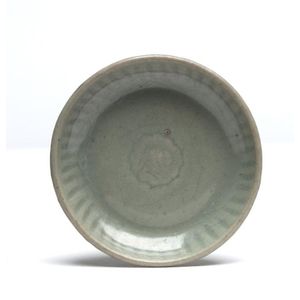Ming Dynasty Celadon Charger with Peony Decoration
You must be a subscriber, and be logged in to view price and dealer details.
Subscribe Now to view actual auction price for this item
When you subscribe, you have the option of setting the currency in which to display prices to $Au, $US, $NZ or Stg.
- Circa - A Latin term meaning 'about', often used in the antique trade to give an approximate date for the piece, usually considered to be five years on either side of the circa year. Thus, circa 1900 means the piece was made about 1900, probably between 1895 and 1905. The expression is sometimes abbreviated to c.1900.
- Charger - A charger is a type of large plate, typically used as a decorative base for smaller plates or bowls. They are often used in formal settings, such as at a banquet or a special occasion.
The history of chargers can be traced back to medieval times, when they were used as a base for serving dishes in banquet settings. They were typically made of metal, such as silver or pewter, and were highly decorative, often featuring intricate engravings or designs.
During the Renaissance period, chargers began to be made of porcelain, and their designs became more ornate. They were often used in the homes of the wealthy and were considered a symbol of wealth and status.
In the 18th and 19th centuries, chargers were produced in great numbers by European porcelain manufacturers, and they were exported to America and other parts of the world. They were highly sought after by the upper class and were often used as a decorative element in formal table settings. - Ming Dynasty - The Ming Dynasty was a ruling dynasty of China from 1368 to 1644. It succeeded the Yuan Dynasty and preceded the Qing Dynasty. The Ming Dynasty was established by Zhu Yuanzhang, a former Buddhist monk who became a rebel leader and eventually overthrew the Mongol Yuan Dynasty. During the Ming Dynasty, China experienced a period of relative stability and prosperity. The government was centralized and bureaucratic, with the emperor at the top of the hierarchy. The Ming Dynasty is known for its cultural achievements, including the development of porcelain, the invention of movable type printing, and the construction of the Great Wall of China.
This item has been included into following indexes:
Visually similar items

A large Longquan charger with impressed floral spray in the interior centre, surrounded by freely executed cloud like motifs on the cavetto surmounted by a band of four horizontal lines, covered in a pale olive green celadon glaze, except for the burned or

A large Longquan charger decorated with two moulded carp in the interior base, and freely executed wave border of the cavetto, a plain wide rim, the exterior side decorated with lotus petals, glazed overall with olive green celadon, except for the foot rim

Three Chinese Longquan celadon vessels, late Song to Yuan dynasty, 13th-14th century, comprising a jarlet, 5.5 cm, a small dish, 10 cm diameter, and a brush washer, 13 cm diameter

A Longquan celadon bowl in grey/green glaze, Song Dynasty (960-1279), 13 cm diameter. Provenance: Sotheby's Australia, The Estate of the Late John Kenny, 17/18 May 2004, Lot 6, Sydney Moss Ltd. London
